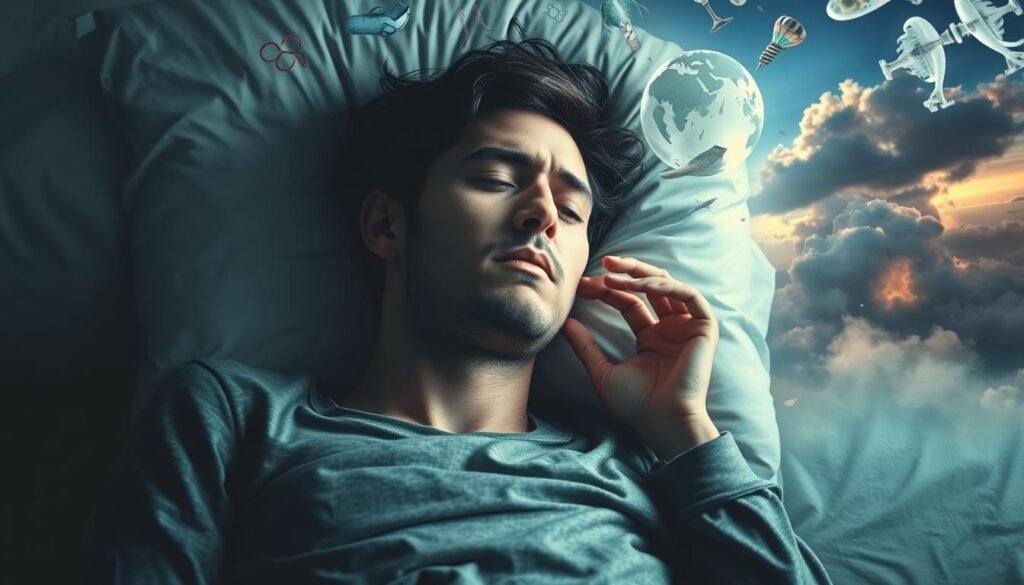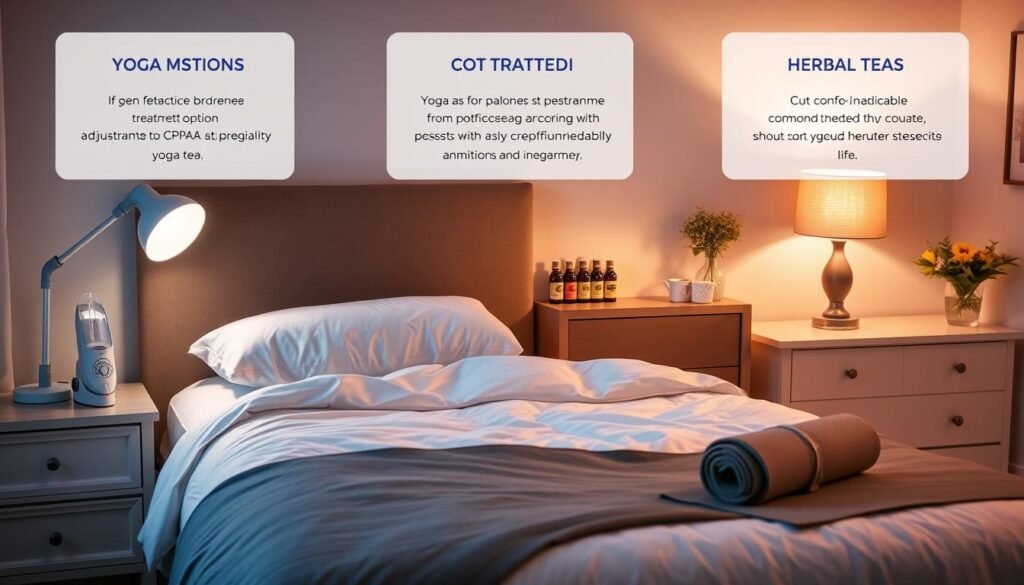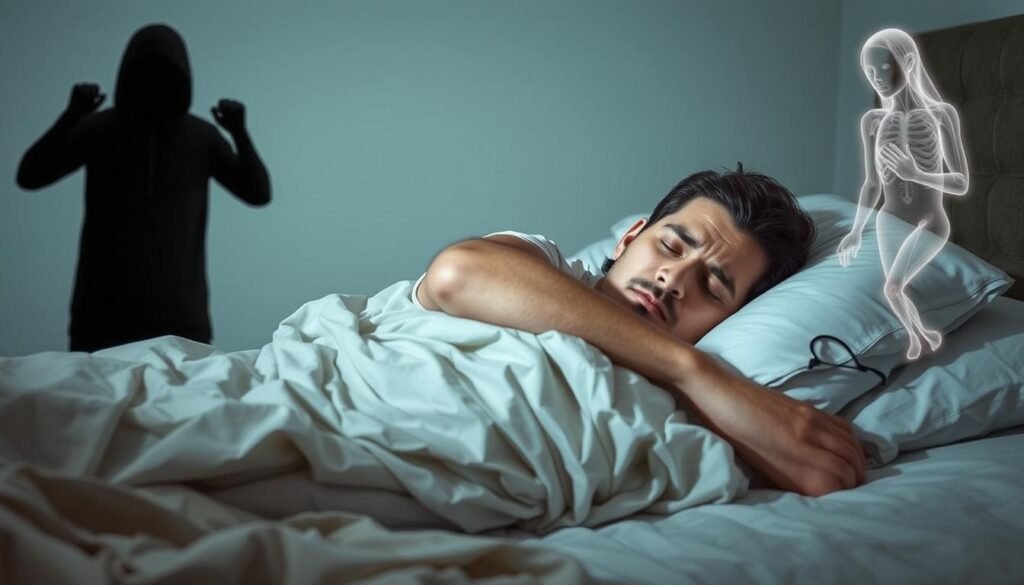Did you know about 1 in 3 people suffer from chronic insomnia? This fact shows how common sleep problems are today. Sleep apnea and insomnia can really hurt how well someone sleeps and their health. Research found that if you have one, there’s a 30-50% chance you’ll have the other. It’s important to understand how they affect each other. This guide will look into their complex relationship, symptoms, and how to diagnose and treat them for better sleep.
Key Takeaways
- Chronic insomnia and sleep apnea are common sleep disorders among adults.
- Individuals with insomnia are 40–60% more likely to have sleep apnea compared to the general population.
- Understanding the connections between these disorders is essential for effective treatment.
- Lifestyle modifications can significantly improve both conditions.
- Cognitive-behavioral therapy (CBT) is recommended for managing chronic insomnia.
- Continuous positive airway pressure (CPAP) therapy is often used to treat sleep apnea.
- Improving sleep hygiene is key to achieving better sleep.
The Connection Between Insomnia and Sleep Apnea
The link between insomnia and sleep apnea is complex. It affects many people. Knowing how they relate helps with better treatments. Around 70 million adults in the U.S. have these sleep issues each year. This shows the importance of more awareness.
Understanding Sleep Disorders
Sleep disorders disturb normal sleep patterns. Insomnia makes it hard to fall or stay asleep. Obstructive sleep apnea (OSA) means your breathing stops and starts because something blocks your airway when you sleep. Many with insomnia might also have OSA. Studies say this is true for 50 to 60 percent of people.
Comorbid Insomnia and Sleep Apnea (COMISA)
Having both insomnia and sleep apnea at once is called COMISA. This combo makes treating each one harder. Each can make the other’s symptoms worse. About 37 percent of those with COMISA also breathe poorly in their sleep. This increases their risk for more health problems.
COMISA patients face tough health issues. Their risk of dying for any reason is 50 percent higher. They also have a bigger chance of getting high blood pressure and heart disease. Between 18% and 42% of people worldwide have COMISA. This highlights the urgent need for better treatments.
It’s key to understand how insomnia and obstructive sleep apnea relate. People with both problems often don’t get enough help. They struggle more during the day and face more health risks. More study is needed to find treatments that can handle both disorders at once.
Symptoms of Sleep Apnea and Insomnia
Knowing the symptoms of these sleep disorders is key for early help. Sleep apnea and insomnia can overlap, making it hard to tell them apart. These symptoms can hurt how well you live, causing tiredness and sleepiness during the day.
Common Symptoms Shared by Both Disorders
Both disorders come with similar symptoms that can be confusing. Some shared symptoms are:
- Loud snoring
- Breathing interruptions during sleep
- Daytime sleepiness
- Fatigue that lasts all day
- Trouble getting or staying asleep
- Irritability and mood swings
These symptoms can really affect daily life and it’s important to spot them early. Many people with one condition might also have the other. This shows why knowing these symptoms is essential.
How Symptoms Overlap and Exacerbate Each Other
Symptoms of these disorders can make each other worse. For example, not sleeping well because of sleep apnea can lead to more insomnia. On the other hand, not being able to sleep can make sleep apnea harder to deal with. This creates a harmful cycle that impacts your health. If you’re caught in this cycle, it’s important to talk to a professional. You might need to look into resources about sleep apnea and its symptoms.
Dealing with these symptoms means treating both disorders well. Without the right treatment, your mental and physical health can get worse from not sleeping well and feeling tired all the time.
Can You Have Sleep Apnea and Insomnia?
When we talk about sleep apnea and insomnia together, we see how complex sleep issues can be. It shows us how factors like age, weight, and our daily choices can make them worse. These factors play a huge part in people having both conditions.
Risk Factors for COMISA
Sleep apnea and insomnia have some risk factors in common. These factors are often the key players:
- Obesity
- Age
- Asthma
- Depression and anxiety
- Gender disparities, especially between men and women
Statistics on Co-occurrence
Recent numbers show that a lot of people with sleep issues have more than one problem. More than half of the people with obstructive sleep apnea also face chronic insomnia. This connection shows why it’s important to pay attention and get the right help for both. Here’s a summary of the most important stats:
| Condition | Percentage of Co-occurrence |
|---|---|
| Obstructive Sleep Apnea | Over 50% with Chronic Insomnia |
| Chronic Insomnia | Up to 60% with Sleep Apnea |
| Effect of Cognitive Behavior Therapy for Insomnia (CBTi) | 15% reduction in OSA severity |
Health Risks Associated with COMISA
COMISA combines insomnia and sleep apnea, raising health risks. It affects heart health and brain function importantly. Understanding these risks helps tackle the effects on those suffering from both.
Cardiovascular and Neurocognitive Effects
COMISA’s health risks are worrying. It boosts the chance of heart diseases a lot. People with COMISA risk dying earlier by 47% more than those who don’t have it. The heart and blood vessels suffer because of bad sleep and breathing pauses.
About 80% of COMISA patients also feel chronic pain. This makes their health risks worse. They might also face memory problems, feel sad, or get depressed more easily. These issues make daily life harder and less happy.
Impact on Quality of Life
COMISA harms more than just physical health. It leads to constant tiredness, quick temper, and trouble thinking. Many miss work more often, hurting their social and financial life. Insomnia is common in sleep apnea patients, affecting 40% to 60% of them. Those with both issues face tougher challenges than having just one.
There’s a big need for doctors to see how insomnia and sleep apnea are connected. Acting early with therapy, medical help, and life changes can lower these health risks. A study found men with both conditions felt more depressed. This shows how mental and physical health are linked (source).

| Health Risk | Description | Statistics |
|---|---|---|
| Cardiovascular Disease | Increased risk of hypertension, stroke, and heart conditions due to disrupted sleep. | 47% higher risk of mortality in COMISA patients. |
| Neurocognitive Effects | Higher prevalence of cognitive decline and mood disorders resulting from poor sleep quality. | 80% of COMISA individuals report chronic pain, influencing mental health. |
| Quality of Life | Reduction in daily functioning, increased absenteeism from work, and overall life satisfaction. | 40%-60% prevalence of insomnia in those with obstructive sleep apnea. |
Diagnosis of Insomnia and Sleep Apnea
Each disorder like insomnia and sleep apnea has its own way of being diagnosed. It’s key to know how to do this right to treat them well.
Diagnosis Methods for Sleep Apnea
Polysomnography is top-notch for finding out if someone has obstructive sleep apnea (OSA). In an overnight study, it looks at brain activity, oxygen in the blood, heart pace, and how one breathes. This detail helps doctors spot OSA by noticing breathing stops during sleep. Knowing this is critical because sleep issues can really affect one’s health.
Assessing Insomnia: Tools and Techniques
When it comes to insomnia, doctors use different tools like surveys, sleep logs, and actigraphy. Surveys gather info on sleep habits. Sleep logs keep an eye on sleep over time. A wrist device used in actigraphy gathers hard data on when you’re asleep or awake. These tools help figure out if you have insomnia. They also show if it’s different from sleep apnea.
Studies point out that 30-50% of people with OSA also feel insomnia signs. This makes finding out what’s wrong a bit complicated. It needs a sharp eye.
So, these sleep issues can sometimes cover up each other’s signs. A thorough check-up is key to deal with them well. This helps patients get much better.
For more info on how these conditions overlap, click here.
Treatment Options for COMISA
COMISA treatment is key for better health. It often includes therapies like Cognitive Behavioral Therapy for Insomnia (CBT-I) and Continuous Positive Airway Pressure (CPAP). These methods help improve sleep and reduce symptoms.
Combination Therapy: CBT-I and CPAP
CBT-I combined with CPAP therapy brings big benefits. CBT-I changes sleep-related thoughts and behaviors. It encourages good sleep habits and relaxation.
CPAP therapy, crucial for sleep apnea, helps patients stick to treatment. Together, they improve sleep more than using either method alone. These treatments can change the lives of those with insomnia and sleep apnea.
Lifestyle Modifications and Self-Care Tips
Lifestyle changes also help manage COMISA. Keeping a regular sleep schedule and cutting back on caffeine are good steps. Adding relaxation exercises like deep breathing can boost sleep health.
- Maintaining a comfortable sleep environment free from distractions.
- Exercising regularly, yet avoiding vigorous exercise close to bedtime.
- Avoiding heavy meals and alcohol before sleep.
- Keeping consistent sleep and wake times.
These habits support better sleep, physical, and mental health. They offer a comprehensive approach to managing COMISA.

| Treatment Option | Description | Benefits |
|---|---|---|
| CBT-I | A structured program that helps to identify and replace thoughts and behaviors that cause or worsen sleep problems. | Improves sleep quality, addresses underlying insomnia, and enhances overall mental health. |
| CPAP Therapy | A device that delivers a constant stream of air to keep airways open during sleep. | Reduces apnea episodes, improves sleep quality, and increases daytime alertness. |
| Lifestyle Modifications | Changes to daily routines, including sleep schedule adjustments and dietary changes. | Enhances overall sleep health and promotes better management of both insomnia and OSA symptoms. |
Improving Sleep Quality with Good Sleep Hygiene
Good sleep practices are key to better sleep quality. Having a regular sleep time and a nice sleep space can lessen sleep troubles. These steps not only help with deep sleep but also improve health overall.
Establishing a Consistent Sleep Schedule
Being regular tells our body when it’s time to sleep. It’s best for adults to get seven to nine hours of sleep nightly. Sticking to a set wake-up time can help.
This routine leads to steady sleep habits for better rest. Making small changes to bedtime can build a lasting schedule. Starting a calming routine before bed, like reading or relaxation exercises, prepares the brain for sleep.
Creating a Comfortable Sleep Environment
A cozy sleep area is crucial for good sleep. The right mattress matters; back sleepers need firm ones, and side sleepers need soft ones. Experts advise getting a new mattress every five to eight years for the best support.
Keeping the room cool and quiet makes it easier to fall asleep. Using calming scents like lavender may also help relax. Avoiding caffeine or alcohol before bed is beneficial for uninterrupted sleep, helping with sleep cleanliness.
Understanding Obstructive and Central Sleep Apnea
There are two main types of sleep apnea: obstructive (OSA) and central (CSA). Each has different signs and symptoms. Knowing these differences helps people find better ways to deal with these conditions.
Differences Between the Two Types
Obstructive sleep apnea happens when throat muscles relax too much and block the airway during sleep. This often leads to loud snoring and gasping for air. On the other hand, central sleep apnea occurs when the brain doesn’t send the right signals for breathing. This type usually doesn’t involve snoring but has other clear signs.
Symptoms Specific to Each Type
Those with obstructive sleep apnea may notice:
- Frequent loud snoring
- Choking or gasping during sleep
- Daytime fatigue and excessive sleepiness
People with central sleep apnea might experience:
- Excessive daytime sleepiness (hypersomnia)
- Trouble focusing and mood changes
- Morning headaches

The symptoms of the two types vary, making diagnosis tricky. Obstructive sleep apnea is more common. But central sleep apnea is often seen in people over 60 and those with heart conditions.
| Type of Sleep Apnea | Common Symptoms | Prevalence and Risk Factors |
|---|---|---|
| Obstructive Sleep Apnea (OSA) | Loud snoring, gasping for air | Common; risk increases with obesity and age |
| Central Sleep Apnea (CSA) | Daytime sleepiness, trouble focusing | Less common; prevalent in older adults and those with heart issues |
Understanding both obstructive and central sleep apnea leads to better treatment choices. This can improve the quality of life for those affected.
Patient-Centered Care Approach
Treating comorbid insomnia and sleep apnea requires focusing on the patient. This approach is about tailoring treatments to fit each patient’s needs. By considering their preferences and symptoms, healthcare providers can greatly improve outcomes.
Incorporating Individual Needs in Treatment
Patient-centered care puts a spotlight on individual needs. Understanding the factors behind conditions like insomnia and sleep apnea leads to better treatment. Studies show that personalized care improves patient satisfaction and treatment adherence. Given the varying responses to positive airway pressure (PAP) treatments, custom plans are essential. They cater to each person’s unique health, boosting therapy effectiveness.
Collaborative Strategies with Healthcare Providers
Collaboration is key in patient-centered care. It involves specialists from areas like sleep medicine and psychiatry working together. Such a team can address various aspects of a patient’s health, creating a multifaceted treatment plan. Integrating cognitive behavioral therapy for insomnia (CBT-I) highlights the need to tackle behavioral issues. For tips on managing insomnia, check out behavioral patterns that cause insomnia.
| Patient Factors | Impact on Treatment |
|---|---|
| Age | Affects prevalence and severity of symptoms |
| Sex | Different prevalence rates observed in men and women |
| Comorbidities | Influences treatment adherence and complexity |
| Patient Preferences | Shapes the choice of treatment strategies |
| Health Literacy | Affects understanding and adherence to treatment |
Conclusion
Understanding how sleep apnea and insomnia connect is key to better sleep. Both conditions make it hard to get good rest. They often mix up, making it hard to tell them apart and treat.
About 40-60% of people with sleep apnea also have chronic insomnia. It’s vital to tackle these issues together for better results.
Knowing the signs of both can lead someone to seek help. Using both cognitive behavioral therapy (CBTi) and CPAP for apnea can really help. This approach can improve life by bringing back restful sleep.
If we ignore these sleep problems, things can get worse. They can lead to other health problems. Working together with doctors can help find better ways to good sleep health.